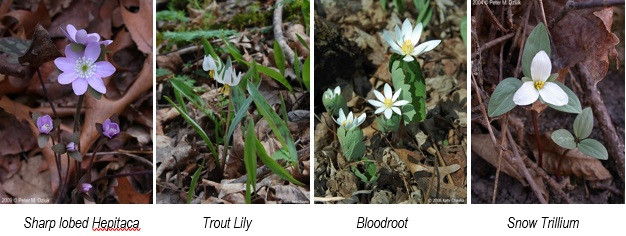Spring is upon us! Some of the first plants to emerge are woodland wildflowers known as spring ephemerals. These short lived gems take advantage of the spring sunlight by completing their life cycles before the forest canopy leafs out for the season. In addition to their beauty, spring ephemerals provide critical resources for pollinators as they emerge in the early spring. Common ephemerals include Hepatica, Trout Lily, Bloodroot, and Trilliums.
Among the first plants to green up in spring, garlic mustard outcompetes native spring ephemeral wildflowers, diminishing early season resources for pollinators and degrading forest health. Garlic mustard has a two year (or biennial) life cycle, producing a short basal rosette without flowers in the first year and a tall "bolting" stalk in the second year. It's important to pull these weeds before they produce seed in the second year. Treat garlic mustard by pulling the whole plant and the roots by hand. If you pull garlic mustard before it flowers, leave the material on the ground to decompose. If you pull it after flowering or seed production, bag it and dispose of it properly so that no seeds are spread.
Learn tricks to help identify and treat garlic mustard from the MN Dept of Ag and Friends of the Mississippi River. Help us protect the beautiful and diverse forests of Anoka County by pulling garlic mustard! For more information contact Logan Olson, Restoration Technician, at
Now is a great time of year to check your property for Garlic Mustard. Garlic Mustard (Alliaria petiolatais) is an invasive species originally from Europe and Asia and typically establishes in the understory of forests and in fields. Garlic Mustard can spread quickly in the wind and can soon start to outcompete native species by emerging earlier, blocking sunlight, and using the limited moisture and nutrients in the ecosystem. Garlic Mustard also releases chemicals into the soil via its roots that alters the important underground network of fungi that connect nutrients between native plants.
During its first year, garlic mustard leaves are rounder and take on a rosette formation at ground level. In their second year, the leaves grow up a flowering stem and become more triangular and heart-shaped with toothed edges. Small white four-petaled flowers emerge in the spring. Hand pulling is an easy way to control small populations of Garlic Mustard and is best done in the spring before they go to seed. These plants can then be placed in a plastic bag and thrown out with the garbage and should not be composted.
Any effort to remove Garlic Mustard from your property might seem daunting, but over time, you will hopefully see native plants start to repopulate the areas you have removed Garlic Mustard.
Learn more about Garlic Mustard here:


